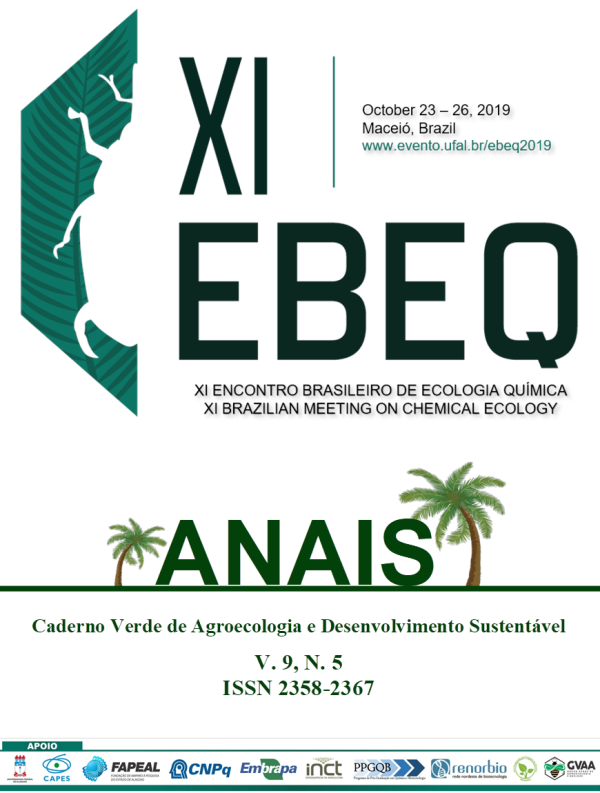IDENTIFICATION AND SYNTHESIS AS TOOLS IN CHEMICAL ECOLOGY TO DECIPHER CHEMICAL MEDIATED INTERACTIONS BETWEEN ORGANISMS
Resumo
The identification of compounds used for communication between individuals of one or different species is fundamental to investigate chemoecological interactions. This is not only true for more traditional methods aiming to characterize a small set of active compounds of a particular interaction, but also mandatory for modern metabolomics approaches dealing with hundreds of compounds. In this contribution the approach followed by my group to identify these compounds will be presented, following two general concepts. A certain interaction can be clarified by isolating, synthesizing and testing target compounds, which is common practice. Besides this approach we also perform reverse Chemical Ecology, starting from Chemistry trying to identify many compounds and evaluate their activity. The latter procedure is exemplified by our work on springtails (Collembola), a sister group of the insects. Although their radiation is much smaller compared to insects, they are important members of many ecosystems. Our group is interested in the chemical ecology of Collembola. The insect epicuticular lipid layer is dominated by complex hydrocarbon mixtures the fatty acid biosynthetic pathway. These specific mixtures often transmit information, e. g. on species identity, sex, physiological state etc. Collembola also use hydrocarbons as epicuticular lipids, but surprisingly these are often terpenes. Instead of complex mixtures, few compounds with unique structures are used. Often irregular terpenes with up to nine isoprene units dominate. Many Collembola also use chemical defense to protect themselves against predators. Such defensive compounds include highly chlorinated or aromatic components. Another project focusses on volatile compounds of bacteria, the function of which are currently intensively investigated in many groups. We are interested in marine an actinomycete, Salinispora, that produces a wide range of volatiles. A combination of various GC/MS and highly sensitive GC/IR techniques with DFT-calculations of IR spectra allowed the proposal of structures of unknown compounds that were verified by synthesis. Other examples of our work will cover Heliconius and ithomiine butterflies from Middle and South America.Downloads
Publicado
Como Citar
Edição
Seção
Licença
Termo de cessão de direitos autorias
Esta é uma revista de acesso livre, em que, utiliza o termo de cessão seguindo a lei nº 9.610/1998, que altera, atualiza e consolida a legislação sobre direitos autorais no Brasil.
O(s) autor(es) doravante designado(s) CEDENTE, por meio desta, publica a OBRA no Caderno Verde de Agroecologia e Desenvolvimento Sustentável, representada pelo Grupo Verde de Agroecologia e Abelhas (GVAA), estabelecida na Rua Vicente Alves da Silva, 101, Bairro Petrópolis, Cidade de Pombal, Paraíba, Brasil. Caixa Postal 54 CEP 58840-000 doravante designada CESSIONÁRIA, nas condições descritas a seguir:
O CEDENTE declara que é (são) autor(es) e titular(es) da propriedade dos direitos autorais da OBRA submetida.
O CEDENTE declara que a OBRA não infringe direitos autorais e/ou outros direitos de propriedade de terceiros, que a divulgação de imagens (caso as mesmas existam) foi autorizada e que assume integral responsabilidade moral e/ou patrimonial, pelo seu conteúdo, perante terceiros.
O CEDENTE mantêm os direitos autorais e concedem à revista o direito de divulgação da OBRA, com o trabalho simultaneamente licenciado sob a Licença Creative Commons do tipo atribuição CC-BY.
O CEDENTE têm autorização para distribuição não-exclusiva da versão do trabalho publicada nesta revista.
O CEDENTE têm permissão e são estimulados a publicar e distribuir seu trabalho online (ex.: em repositórios institucionais ou na sua página pessoal) a qualquer ponto antes ou durante o processo editorial, já que isso pode gerar alterações produtivas, bem como aumentar o impacto e a citação do trabalho publicado.










